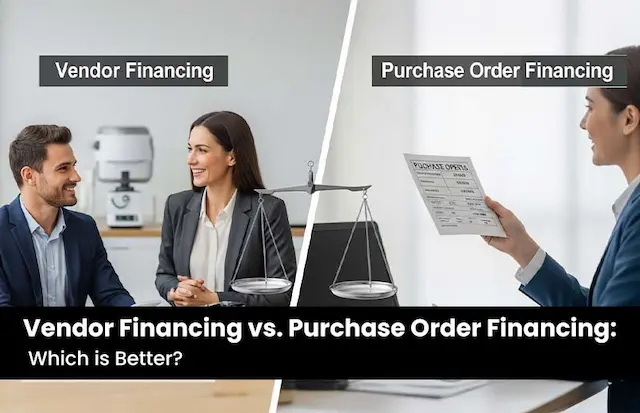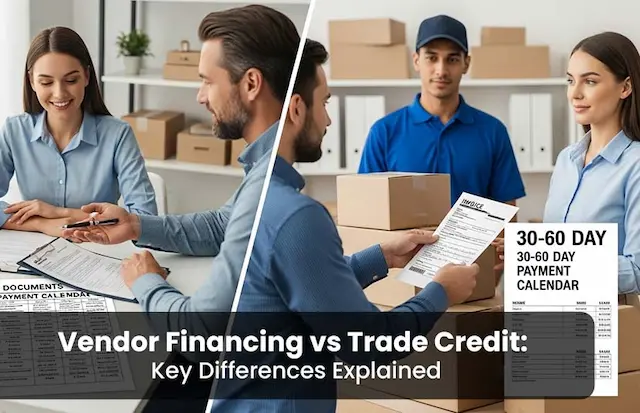Negotiating vendor financing terms is an important element of business strategy that redirects cash flow, thereby fueling growth and creating lasting relationships with suppliers. As credit markets grow more restrictive, businesses must have a considerable strategy when engaging in vendor finance conversations, and it requires being prepared and negotiating effectively. In this guide, we will outline the fundamentals of vendor financing and recommend strategies to secure the best terms possible. It also provides practical recommendations to develop long-term, mutually beneficial vendor relationships.
Understanding Vendor Financing: Key Concepts
Vendor financing (also known as trade credit) is an agreement whereby suppliers provide the buyer with terms allowing payment at or after a later date for goods or services, and thereby allowing companies to spend cash on other potential projects rather than loans or traditional financing. The three main kinds of vendor financing are:
- Supplier Credit: Vendors ship and deliver products upfront, and the buyer pays for the product at a later date, potentially with some interest or fees associated with the agreed-upon vendor finance terms and conditions.
- Purchase Order Financing: This is when a financier makes the payment to the vendor on behalf of the buyer, and the buyer then repays the financier gradually over time.
- Equity Vendor Financing: In some situations, particularly in the high-growth startup environment, buyers can pay for goods using shares of the company’s stock as payment.
Essential Factors in Vendor Finance Negotiations
Businesses need to appreciate the influential drivers of vendor finance arrangements. These drivers could help ensure that due diligence prepares the business for the negotiating stage and mitigates risk. The factors to consider are:
- Vendor Reputation and Financial Strength: Companies will be in better positions if they are dealing with financially stable vendors who will deliver their product/service reliably, consistently, and on time.
- Condition of Credit Terms: Understand the vendor’s credit terms and payment schedule to be able to determine the proper conditions, i.e., credit terms with a new vendor to obtain low-cost finance.
- Written Terms and Documentation: All details, including payment schedule, collateral, and guarantees, should be provided in writing to reduce the opportunity for future disputes and clarify vendor finance terms.
- Impact on Business Relationship: The vendor financing arrangement should not hinder a longer-term supplier relationship, but enhance it.
- Business Cash-flow: To align vendor cash-flow terms with your business, payment terms need to be in line with the nature of business revenue cycles. It is vital to understand vendor payment terms when negotiating with vendors payment terms.
Best Practices for Vendor Finance Negotiations
Vendor financing negotiation involves the combination of financial acumen, relationship management, and foresight. Below includes a full procedure for negotiating vendor finance terms to ensure you achieve both immediate value and long-term benefits from vendor terms:
Preparing for Negotiation
A proper plan and research will help ensure that you negotiate with confidence during any vendor financing negotiation.
- Identify Business Needs: Evaluate capital available for working capital and your operating cycle, to be able to identify what terms will be best for you.
- Market Research: Retrieve data on the latest industry practices and competitor terms for benchmarking to improve your position.
- Use Professional Advisers: For large deals or complicated situations, talk to a legal or finance advisor to know what risks or regulations apply while structuring vendor finance terms.
- Build Internal Consensus: Align agreement in your finance and operations teams on the goals of the negotiation and your non-negotiable items.
Negotiation Strategies
Follow a methodical collaborative process when negotiating vendor payment terms. Key strategies include:
- Set Objectives: Determine exactly what you want—longer payment terms, lower finance rates, flexible payment plans, or even discounts on early payment—all based on vendor finance terms and conditions.
- Clear Communication: Be very clear, upfront, and specific about cashflow cycles and ability to pay; this decreases the risk of miscommunication occurring, which can facilitate trust between both parties.
- Leverage Volume or Loyalty: Offer greater quantities or extend the long-term order schedule in exchange for more favorable payment terms – vendors will get rewarded as well, so they will work to lower your price or offer better payment terms.
- Consider Other Competing Offers: Use a proposal from a competing vendor in the same industry to provide a baseline, and a position to improve your negotiating position, ensuring stronger vendors terms finance.
- Negotiate: Define your acceptable interest rates, penalties, and payment structures. Explore flexible financing solutions such as step-up business loan payments or step-down repayment options to strengthen your position.
- Document the Agreement: Document any agreed-upon terms of payment once negotiated, in a binding legal contract; this will minimize the opportunity for confusion and misunderstanding in the future.
Managing Risks in Vendor Financing
Vendor finance agreements have risks that can result in losses if due diligence is not performed to manage the vendor relationship through continuous monitoring. Here are a few vendor financing tips to manage the risks effectively:
- Conduct Due Diligence: Investigate the vendor’s financial performance and ability to fulfill large and/or complex orders.
- Specify Collateral Provisions: Identify what assets are pledged and the nature of collateral if the vendor has recourse against a company asset.
- Monitor Performance: Conduct regular reviews of payment terms, completion and performance, and compliance with vendor finance terms.
- Plan for Backstops: Realize that vendor finance may be disrupted and have access to alternative supply or finance in the event of a dispute or vendor default.
Benefits of Effective Vendor Finance Negotiations
If best practices are adhered to and responsive terms are well-aligned with a company’s business strategy, companies receive the following benefits:
- Increased Cash Management: Contractually deferring payment extends working capital for the company for operations and investments.
- Stronger Supplier Relationship: Well-negotiated vendor financing terms reinforce long-term supplier relationships, extending from mutually beneficial transactions.
- Lower Overall Finance Costs: Early pay discounts marginally, along with discounted interest rates, together represent lower finance costs.
- Increased Flexibility: Customize terms that allow a business to respond to cyclical markets and unexpected costs.
Strengthen Your Business with Smart Vendor Financing
Negotiating favorable terms and conditions is an excellent opportunity to improve cash flow and establish long-term relationships. While ensuring there are viable and defined goals, good planning, and open communication within the process, any organization can achieve vendor financing that is flexible and beneficial. For businesses that want vendor financing to be more transparent, predictable, and ultimately provide strategic value, Credlix has new innovative solutions that provide confidence in the negotiating process and optimize working capital.
Frequently Asked Questions
Q1: What kind of vendor financing exists?
Supplier credit, purchase order funding, leasing, and equity vendor financing are the different types of vendor financing options that fit into different cash flow and operational situations.
Q2: How does vendor financing help support business growth?
Vendor financing allows you to access products or services that you might otherwise have to wait for while investing that upfront capital into growth, giving you liquidity back that frees up your other funds.
Q3: What are the risks associated with vendor financing?
Risks may include vague vendor terms, over-dependence on one supplier, poor collateral demands, or repayment disputes, all warranting preparations and unique vendor financing tips.





